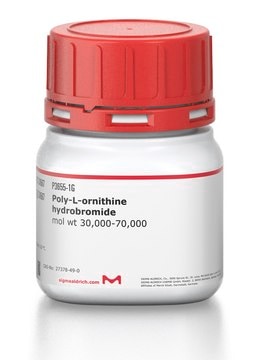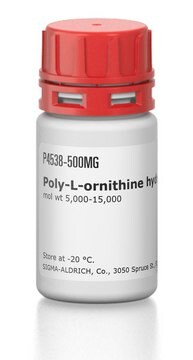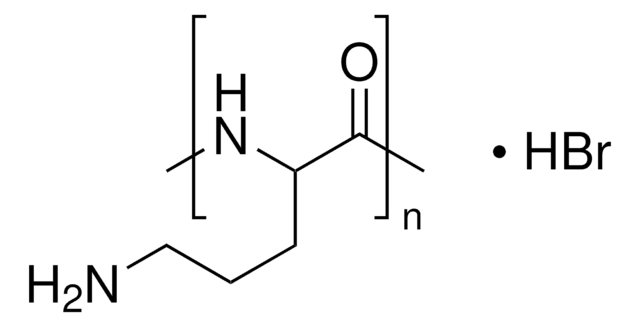P4638
Poly-L-ornithine hydrobromide
suitable for cell culture, Mol wt >100,000
Synonyme(s) :
L-Ornithine homopolymer hydrobromide
About This Item
Produits recommandés
product name
Poly-L-ornithine hydrobromide, mol wt >100,000
Forme
powder
Poids mol.
>100,000
Technique(s)
cell culture | mammalian: suitable
Couleur
white to off-white
Température de stockage
−20°C
InChI
1S/C5H12N2O2.BrH/c6-3-1-2-4(7)5(8)9;/h4H,1-3,6-7H2,(H,8,9);1H
Clé InChI
GWRQMKDBBHFVIZ-UHFFFAOYSA-N
Vous recherchez des produits similaires ? Visite Guide de comparaison des produits
Application
- Thermodynamic Characterization of Polypeptide Complex Coacervation.: The research investigates the thermodynamic properties of polypeptide complex coacervation, including the role of Poly-L-ornithine hydrobromide in these interactions. This study provides insights into the self-assembly processes of polypeptides, which are crucial for designing new biomaterials (Priftis et al., 2012).
Remarque sur l'analyse
Autres remarques
Code de la classe de stockage
11 - Combustible Solids
Classe de danger pour l'eau (WGK)
WGK 3
Point d'éclair (°F)
Not applicable
Point d'éclair (°C)
Not applicable
Équipement de protection individuelle
Eyeshields, Gloves, type N95 (US)
Certificats d'analyse (COA)
Recherchez un Certificats d'analyse (COA) en saisissant le numéro de lot du produit. Les numéros de lot figurent sur l'étiquette du produit après les mots "Lot" ou "Batch".
Déjà en possession de ce produit ?
Retrouvez la documentation relative aux produits que vous avez récemment achetés dans la Bibliothèque de documents.
Articles
Humankind has utilized protein materials throughout its existence, starting with the use of materials such as wool and silk for warmth and protection from the elements and continuing with the use of recombinant DNA techniques to synthesize proteins with unique and useful properties.
Notre équipe de scientifiques dispose d'une expérience dans tous les secteurs de la recherche, notamment en sciences de la vie, science des matériaux, synthèse chimique, chromatographie, analyse et dans de nombreux autres domaines..
Contacter notre Service technique






